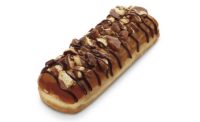Raising the Bar
Mainstream consumers did not immediately embrace sports bars, which often were dry, hard and crumbly. Eventually, the sensory quality of products improved, and sports bars moved into the limelight. The Nutrition Business Journal reports the almost-$10 billion U.S. sports nutrition and weight loss product category showed the greatest growth at 15% in 2001.

Staying Flexible
While nutrition bars are generally safe to eat within a year of manufacture, they tend to harden before their shelf-life expires. Water molecules migrate to the protein, causing molecular linkages to form, binding the water which results in a less flexible bar texture. Syrups and other ingredients such as oils and glycerine can help bars maintain their softness, but such components often are not well-received in the sports industry, explains Steve Rittmanic, director of product development for Protient, Inc., St. Paul, Minn., a whey protein manufacturer. Syrups and oils add extra calories. Glycerine is metabolized similarly to carbohydrates, which some athletes consider undesirable, given the recent publicity focused on negative aspects of carbohydrates related to weight gain.
While nutrition bars are generally safe to eat within a year of manufacture, they tend to harden before their shelf-life expires. Water molecules migrate to the protein, causing molecular linkages to form, binding the water which results in a less flexible bar texture. Syrups and other ingredients such as oils and glycerine can help bars maintain their softness, but such components often are not well-received in the sports industry, explains Steve Rittmanic, director of product development for Protient, Inc., St. Paul, Minn., a whey protein manufacturer. Syrups and oils add extra calories. Glycerine is metabolized similarly to carbohydrates, which some athletes consider undesirable, given the recent publicity focused on negative aspects of carbohydrates related to weight gain.

Food formulators working with protein isolates need quality systems with clean, bland flavors so that they can impart their own trademark flavors, without off-flavors. On labels, the ingredient can appear as “hydrolyzed whey protein isolate.”
For more information:
David Lenzmeier at 651-638-2600
Dlenzmeier@protient.com • www.protient.com
Protient WRITE IN 20
Looking for a reprint of this article?
From high-res PDFs to custom plaques, order your copy today!



